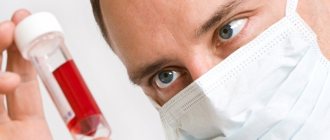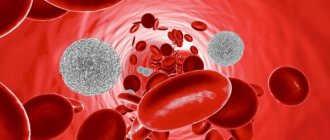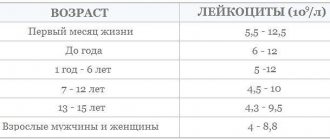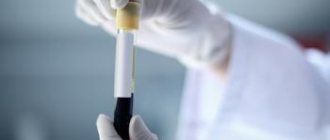Interpretation of indicator values
Based on the results of the UAC, the specialist checks the state of hemoglobin. It is assessed using three columns - hemoglobin, color index and the average hemoglobin content in one red blood cell.
The accuracy of the diagnosis and the correctness of treatment depend on the accuracy of the blood test results.
The following is also analyzed:
- hematocrit and an increased number of red blood cells (RBC) show whether the child is consuming enough fluid (we recommend reading: the child’s hematocrit is increased: what does this mean?);
- Neutrophils and eosinophils will help assess the baby’s immune reserve;
- the presence of inflammation is indicated by ESR;
- lymphocytes (LYM) and neutrophils indicate a viral or bacterial infection (we recommend reading: what to do if neutrophils in a child’s blood are low?).
READ ALSO: what does it mean if a child has elevated red blood cells?
Hemoglobin concentration (HGB)
Hemoglobin consists of protein and iron. Its main tasks are the binding of oxygen and its supply to the organs. The transport characteristics of blood, the functioning of the brain, lungs, heart, and the body as a whole directly depend on the saturation of hemoglobin. In the results, its concentration is designated Hb, HGB or hemoglobin.
A large amount of hemoglobin is characteristic of blood diseases, diabetes, various pathologies of the kidneys, heart, and lungs. When the level is low, the cause may be an unbalanced diet, congenital or acquired anemia, or leukemia.
Lymphocytes (LYM)
Lymphocytes belong to the leukocyte lineage and perform a protective function. Lymphocytes are most often designated by the abbreviations LY, LYM or LUM.
Depending on their purpose, they are divided into the following groups:
- B lymphocytes - responsible for immunity after the body collides with a virus or bacteria;
- T-lymphocytes are called killers - they are entrusted with the role of destroying any foreign cells;
- T-lymphocyte assistants are T-killers;
- Suppressor T cells are responsible for ensuring that healthy cells are not harmed;
- atypical ALY lymphocytes appear in children only when exposed to antigens.
LYM is calculated taking into account the total number of leukocytes, but absolute numbers are also found in the analysis results. In the latter case, the norm in children is considered to be 1-4 billion per liter. The absolute number of lymphocytes can be determined independently based on the results of a general blood test, using the formula: LC x LF% = LF, where LC is the number of leukocytes, and LF is lymphocytes as a percentage. If the required number according to the formula corresponds to the norm, there is no need to worry.
The normal level of lymphocytes in children is considered to be 30-70%. Moreover, the main part of them is found in tissues (tonsils, spleen, lymph nodes, bone marrow, appendix), and only 2 percent in the blood. Decoding the CBC includes an assessment of the content of lymphocytes in the body. If the latter are more than expected, the condition is called lymphocytosis. Otherwise – leukopenia.
- Leukocytes in the blood: normal indicators in tables by age
Red blood cells (RBC)
Red blood cells (RBCs) help oxygenate the organs and tissues of the body, while they transfer the carbon dioxide released back to the lungs. Anisocytosis, or a decrease in red blood cells not due to a pathological condition, can be caused by excessive fluid intake.
An increased amount of rbc is extremely rare and is called erythremia or erythrocytosis. The reasons for such a deviation may be due to:
- presence of blood disease;
- physical activity;
- lung or heart problems;
- accommodation in mountainous areas;
- poisoning;
- dehydration.
White blood cells (WBC)
Leukocytes (WBC) are white blood cells that protect the body's immune forces, creating humoral and cellular immunity. An elevated reading during pregnancy or intense exercise is not considered a deviation. If these factors are excluded, the cause is an allergy, viral or bacterial infection. A low WBC count indicates weak immunity.
The ratio of all types of leukocytes as a percentage is displayed in the leukocyte formula. The MID data indicated in it makes the analysis more informative and allows you to immediately determine which leukocytes are outside the normal range.
READ ALSO: What is the norm of leukocytes in the blood of a 1-year-old child?
Causes of increased wbc: injury, burn, liver disease, anaphylactic shock, malignant neoplasm, internal bleeding or renal colic. The impetus for a decrease in white blood cells is a viral disease, intoxication of the body, or an endocrine disorder.
Platelets (PLT)
Platelets are blood cells responsible for blood clotting. More precisely, they are entrusted with two tasks - creating a platelet aggregate when the walls of vascular beds are damaged and accelerating plasma coagulation.
The growth of platelets is called thrombocytosis - it is characteristic of an inflammatory or infectious process in the body, trauma and significant blood loss, hematological pathologies, leukemia, as well as the use of corticosteroids, sympathomimetics, and antimycotics. Thrombocytopenia, or low platelet levels, may be due to an allergic reaction, hemophilia, a virus, or a malignant tumor.
READ IN DETAIL: What do low platelets in a child’s blood mean?
- Blood test after chemotherapy: normal, interpretation, general blood test
Erythrocyte sedimentation rate (ESR)
Erythrocyte sedimentation rate is an important non-specific indicator. Essentially, ESR means how quickly red blood cells settle and stick together in a test tube. With its help, the degree of the inflammatory process is determined. An increase in ESR is a slow process, and the same thing happens with a return to normal.
ESR higher than normal occurs in diseases of an infectious nature, kidney pathologies, rheumatism and malignant neoplasms.
Neutrophils (NEUT)
Cells that resist any foreign formations are called neutrophils. They not only help the body cope with the disease, but also eliminate its own non-living microparticles.
Neutrophilia, when the number of cells is increased, can be of both physiological and pathological nature. In the first case, the trigger is stress or poor nutrition, and in the second, a number of diseases: burns, blood cancer, inflammation, blood loss, insect bites, removal of the spleen.
If the level of neutrophils is low, the condition is called neutropenia. It appears due to one of the reasons:
- flu;
- taking cytostatics and antibiotics;
- radiation;
- HIV;
- lack of vitamins;
- bone marrow depletion;
- toxoplasmosis;
- lupus;
- measles
Eosinophils (EOS)
The subtype of white blood cells responsible for detecting and eliminating foreign protein is called eosinophils. They help cleanse the body of toxins, parasites and actively fight cancer. Using the eosinophil count, the doctor determines whether the patient has an allergy. When the number of cells exceeds the norm, one of the following pathologies may be to blame:
- oncology;
- helminthic infestations;
- diseases of the hematopoietic system;
- allergy.
An insufficient number of eosinophils indicates an inflammatory process. In addition, childbirth or infection of the body are provocateurs.
Monocytes (MON)
Monocytes are large immune cells that are another type of white blood cell. They recognize and cleanse tissues of viruses, bacteria, damaged cells, including tumor cells.
READ IN DETAIL: why can monocytes in a child’s blood be increased? An increased number of cells (monocytosis) is a common occurrence after an infectious disease (syphilis, brucellosis, tuberculosis) or other pathology (arthritis, sarcoidosis, leukemia).
- What foods can increase white blood cells in the blood - List of the 10 most effective
Monocytopenia can also occur due to blood cancer. Other reasons for its appearance: postoperative condition, taking hormonal drugs, osteomyelitis, phlegmon and abscess.
Basophils (BAS)
Basophils are a type of leukocyte that is the first to detect anything foreign in the body. They, one might say, “engage in battle” with toxic substances and allergens, resist inflammation and restore blood flow.
If the basophil count has increased, this may be due to a problem with the thyroid gland and lymphatic system, allergies, smallpox, or taking hormonal drugs. The decrease in basophils is affected by stress, pregnancy and increased levels of hormones.
General blood test: interpretation in adults
General clinical blood test: the norm of red blood cells is from 3.7 to 5.1 per 10 to 12 cells per 1 liter, the concentration of hemoglobin in them is 120-140 g/l in women and 130-160 g/l in men.
The blood test is general and its interpretation requires an assessment of the shape of the red blood cells, which normally represent a biconcave disc. Changes in these indicators may indicate iron deficiency and anemia, or blood thickening. Indicators of a general blood test and their norm help determine the type of anemia, its possible cause, etc.
The number of “young” red blood cells - reticulocytes - in a general fasting blood test is in the range of 0.2-1.2%. They increase with increased hematopoiesis, accelerated destruction of mature red blood cells (hemolysis) and decrease with anemia, kidney disease, thyroid disease, consequences of radiation exposure, etc.
Platelets
Platelets are also red blood cells. They look like small plates. Their main purpose is normal blood clotting.
Platelets in test results indicate:
- tr.;
- PLT;
- platelets.
Table No. 6: platelet norms in children
There are:
- Thrombocytopenia - when platelets in the blood are less than normal;
- Thrombocytosis - if more than normal.
Let's decipher the results:
- Clinical blood analysis: from light microscope to hematological analyzers
In modern laboratories, platelet indices are also determined.
General blood test and its interpretation
The indicators of a general fasting blood test are assessed (the price of the test is available to everyone) by quantity, percentage and quality. They evaluate “red blood cells” - red blood cells, which, with the help of hemoglobin, carry oxygen throughout the body. Also, the indicators of the general blood test of a child and an adult, which are deciphered in children and adults at prices below average, are carried out by us, help to evaluate all types of white blood cells - leukocytes and blood platelets - platelets. The former are responsible for many processes in the body related to the functioning of the immune system, and the latter are responsible for the ability of blood to clot.
What is the leukocyte formula and what indicators are studied in it?
Leukocytes are white blood cells that participate in the process of protecting the body from pathogenic factors and microorganisms. There are several types of leukocytes. The number of blood cells changes as a person grows older and as their health changes. The leukocyte formula (leukogram) is the ratio of various white blood particles to their total number in percentage terms.
Types of leukocytes:
| Group | Species, subspecies | Description and functions | ||
| Granulocytes | Neutrophils | Segmented | Kills viruses and bacteria | They form the basis of the body's defense. |
| Rod | Formed if segmented cells cannot cope with a bacterial infection. | |||
| Myelocytes | Appear only in cases of severe illness. | |||
| Eosinophils | They protect against parasites, respond to allergies, oncology, and autoimmune problems. | |||
| Basophils | Prevents the spread of bacteria and toxins. | |||
| Agranulocytes | Lymphocytes | Participate in the production of antibodies and are responsible for the formation of immunity. | ||
| Monocytes | They destroy harmful elements and cleanse the blood of dying cells. |
READ ALSO: Why are monocytes and eosinophils in a child’s blood elevated?
Laboratory blood test to determine the concentration of leukocytes
A change in one of the indicators (types of white cells) of the leukocyte formula indicates the activation of pathological processes or disruption of the body systems. In this case, it is possible to increase the number of one type of leukocyte and decrease the content of another. Only a comprehensive analysis of the elements shows a reliable picture of a person’s health status.
General clinical blood test for a child interpretation
Children's bodies continue to develop and adapt to the changes associated with growing up. Therefore, the data of a general fasting blood test in children of different age groups are different.
A general clinical blood test for a child under one year of age does not differ in price from an adult. Interpretation: Number of erythrocytes - 4.3-7.6 per 10 to 12 cells/l, reticulocytes - 3-51%, hemoglobin concentration - 180-240 g/l, platelets - 180-490 per 10 to 9 cells/ l, leukocyte level – 8.5-24.5 per 10 to 9 degrees, ESR – 2-4 mm/hour.
The ratio of types of leukocytes: eosinophils - 0.5-6%, basophils - 0-1%, band netrophils 1-17%, and segmented ones - 45-80%, lymphocytes 12-36%, monocytes - 2-12%;
General blood test in children (the price is quite affordable) older than 1 year:
The number of erythrocytes decreases - 3.6-4.9 per 10 in 12 cells/l, hemoglobin - 110-135 g/l, reticulocytes - 3-15%, leukocytes - 6.0-12.0 per 10 in 9 degrees. ESR becomes closer to adult levels - 4-12 mm/hour.
Diagnostics
If leukocytes are detected in the urine in quantities exceeding the norm, a repeat analysis is necessary to exclude collection defects. In addition, the baby is additionally prescribed a urine test according to Nechiporenko to confirm the increase in leukocytes. The doctor may also prescribe for the child:
- urine culture to identify pathogenic bacteria in it;
- Ultrasound of the kidneys and bladder to determine the problem;
- blood tests (general, biochemical);
- X-rays may sometimes be required;
If all the results are available, the doctor will determine the diagnosis that led to the increase in leukocytes, and the treatment tactics will depend on it.
Modern methods of treatment
Treatment is necessary in situations where leukocytes in the urine are a sign of pathology.
Most often it is a urinary tract infection caused by bacteria. In this case, antibiotics, plenty of fluid intake, uroseptics and anti-inflammatory drugs, and diet are indicated. If certain developmental defects are detected, operations may be performed to restore the integrity of the urinary tract.
If leukocytes appear against the background of salts or crystals in the urine (nephropathy), a diet and correction of the pH (acidity) of urine through medications and fluid intake are indicated.
Result evaluation
The color indicator, depending on the norm, can be:
- hyperchromic (more than 1.05),
- normochromic (0.85–1.05),
- hypochromic (less than 0.85).
Correct assessment helps in diagnosing different types of anemia (anemia).
The analysis form includes MSN (fourth from the top)
Hyperchromia is detected when:
- pernicious anemia;
- lack of folic acid and other vitamins in the body;
- malignant diseases;
- benign polypous growths in internal organs.
Reduced values accompany anemia:
- arising in connection with acute or prolonged chronic blood loss;
- with a lack of iron (iron deficiency anemia);
- with anemia in pregnant women;
- associated with lead intoxication.
Normochromia is possible with a simultaneous lack of both hemoglobin and red blood cells. Such conditions are observed when:
- various diseases of the blood and hematopoietic organs;
- acute and chronic poisoning with toxic substances;
- action of penetrating radiation.
In hematology, the indicator indicates the regenerative capacity of the bone marrow. If it is very high, and under the influence of treatment it returns to normal, the analysis is regarded as a positive change and the beginning of red blood cell synthesis. It is included in the assessment of achieving remission in chronic anemia.










